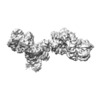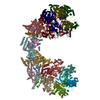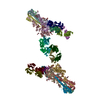+ Open data
Open data
- Basic information
Basic information
| Entry | Database: EMDB / ID: EMD-11219 | |||||||||
|---|---|---|---|---|---|---|---|---|---|---|
| Title | Cryo-EM structure of DNA-PK dimer | |||||||||
 Map data Map data | ||||||||||
 Sample Sample |
| |||||||||
 Keywords Keywords | Kinase / DNA-PKcs / NHEJ / DNA-repair / DNA-PK / DNA BINDING PROTEIN / Ku70/80 | |||||||||
| Function / homology |  Function and homology information Function and homology informationpositive regulation of platelet formation / Ku70:Ku80 complex / negative regulation of t-circle formation / T cell receptor V(D)J recombination / DNA end binding / pro-B cell differentiation / small-subunit processome assembly / DNA-dependent protein kinase activity / positive regulation of lymphocyte differentiation / DNA-dependent protein kinase complex ...positive regulation of platelet formation / Ku70:Ku80 complex / negative regulation of t-circle formation / T cell receptor V(D)J recombination / DNA end binding / pro-B cell differentiation / small-subunit processome assembly / DNA-dependent protein kinase activity / positive regulation of lymphocyte differentiation / DNA-dependent protein kinase complex / histone H2AXS139 kinase activity / DNA-dependent protein kinase-DNA ligase 4 complex / immunoglobulin V(D)J recombination / nonhomologous end joining complex / immature B cell differentiation / regulation of smooth muscle cell proliferation / cellular response to X-ray / regulation of epithelial cell proliferation / double-strand break repair via alternative nonhomologous end joining / double-strand break repair via classical nonhomologous end joining / nuclear telomere cap complex / Cytosolic sensors of pathogen-associated DNA / telomere capping / IRF3-mediated induction of type I IFN / regulation of hematopoietic stem cell differentiation / positive regulation of neurogenesis / recombinational repair / regulation of telomere maintenance / protein localization to chromosome, telomeric region / U3 snoRNA binding / maturation of 5.8S rRNA / T cell lineage commitment / cellular hyperosmotic salinity response / negative regulation of cGAS/STING signaling pathway / positive regulation of double-strand break repair via nonhomologous end joining / B cell lineage commitment / 2-LTR circle formation / hematopoietic stem cell proliferation / telomeric DNA binding / negative regulation of protein phosphorylation / positive regulation of protein kinase activity / Lyases; Carbon-oxygen lyases; Other carbon-oxygen lyases / site of DNA damage / peptidyl-threonine phosphorylation / 5'-deoxyribose-5-phosphate lyase activity / hematopoietic stem cell differentiation / ATP-dependent activity, acting on DNA / somitogenesis / ectopic germ cell programmed cell death / telomere maintenance via telomerase / mitotic G1 DNA damage checkpoint signaling / neurogenesis / DNA helicase activity / activation of innate immune response / telomere maintenance / cyclin binding / positive regulation of erythrocyte differentiation / cellular response to leukemia inhibitory factor / positive regulation of translation / response to gamma radiation / Nonhomologous End-Joining (NHEJ) / small-subunit processome / enzyme activator activity / cellular response to gamma radiation / protein-DNA complex / regulation of circadian rhythm / brain development / peptidyl-serine phosphorylation / protein modification process / protein destabilization / double-strand break repair via nonhomologous end joining / Hydrolases; Acting on acid anhydrides; Acting on acid anhydrides to facilitate cellular and subcellular movement / cellular response to insulin stimulus / intrinsic apoptotic signaling pathway in response to DNA damage / rhythmic process / T cell differentiation in thymus / double-strand break repair / E3 ubiquitin ligases ubiquitinate target proteins / heart development / double-stranded DNA binding / scaffold protein binding / secretory granule lumen / DNA recombination / transcription regulator complex / ficolin-1-rich granule lumen / damaged DNA binding / RNA polymerase II-specific DNA-binding transcription factor binding / chromosome, telomeric region / protein phosphorylation / non-specific serine/threonine protein kinase / protein kinase activity / transcription cis-regulatory region binding / positive regulation of apoptotic process / ribonucleoprotein complex / protein domain specific binding / innate immune response / protein serine kinase activity / negative regulation of DNA-templated transcription / protein serine/threonine kinase activity / DNA damage response Similarity search - Function | |||||||||
| Biological species |  Homo sapiens (human) Homo sapiens (human) | |||||||||
| Method | single particle reconstruction / cryo EM / Resolution: 7.24 Å | |||||||||
 Authors Authors | Chaplin AK / Hardwick SW | |||||||||
| Funding support |  United Kingdom, 1 items United Kingdom, 1 items
| |||||||||
 Citation Citation |  Journal: Nat Struct Mol Biol / Year: 2021 Journal: Nat Struct Mol Biol / Year: 2021Title: Dimers of DNA-PK create a stage for DNA double-strand break repair. Authors: Amanda K Chaplin / Steven W Hardwick / Shikang Liang / Antonia Kefala Stavridi / Ales Hnizda / Lee R Cooper / Taiana Maia De Oliveira / Dimitri Y Chirgadze / Tom L Blundell /  Abstract: DNA double-strand breaks are the most dangerous type of DNA damage and, if not repaired correctly, can lead to cancer. In humans, Ku70/80 recognizes DNA broken ends and recruits the DNA-dependent ...DNA double-strand breaks are the most dangerous type of DNA damage and, if not repaired correctly, can lead to cancer. In humans, Ku70/80 recognizes DNA broken ends and recruits the DNA-dependent protein kinase catalytic subunit (DNA-PKcs) to form DNA-dependent protein kinase holoenzyme (DNA-PK) in the process of non-homologous end joining (NHEJ). We present a 2.8-Å-resolution cryo-EM structure of DNA-PKcs, allowing precise amino acid sequence registration in regions uninterpreted in previous 4.3-Å X-ray maps. We also report a cryo-EM structure of DNA-PK at 3.5-Å resolution and reveal a dimer mediated by the Ku80 C terminus. Central to dimer formation is a domain swap of the conserved C-terminal helix of Ku80. Our results suggest a new mechanism for NHEJ utilizing a DNA-PK dimer to bring broken DNA ends together. Furthermore, drug inhibition of NHEJ in combination with chemo- and radiotherapy has proved successful, making these models central to structure-based drug targeting efforts. #1:  Journal: Nat.Struct.Mol.Biol. / Year: 2020 Journal: Nat.Struct.Mol.Biol. / Year: 2020Title: Dimers of DNA-PK create a stage for DNA-double strand break repair Authors: Chaplin AK / Hardwick SW / Liang S / Stavridi AK / Hnizda A / Cooper LR / De Oliveira TM / Chirgadze DY / Blundell TL | |||||||||
| History |
|
- Structure visualization
Structure visualization
| Movie |
 Movie viewer Movie viewer |
|---|---|
| Structure viewer | EM map:  SurfView SurfView Molmil Molmil Jmol/JSmol Jmol/JSmol |
| Supplemental images |
- Downloads & links
Downloads & links
-EMDB archive
| Map data |  emd_11219.map.gz emd_11219.map.gz | 631.9 MB |  EMDB map data format EMDB map data format | |
|---|---|---|---|---|
| Header (meta data) |  emd-11219-v30.xml emd-11219-v30.xml emd-11219.xml emd-11219.xml | 29.8 KB 29.8 KB | Display Display |  EMDB header EMDB header |
| FSC (resolution estimation) |  emd_11219_fsc.xml emd_11219_fsc.xml | 25.9 KB | Display |  FSC data file FSC data file |
| Images |  emd_11219.png emd_11219.png | 32.9 KB | ||
| Filedesc metadata |  emd-11219.cif.gz emd-11219.cif.gz | 9.9 KB | ||
| Others |  emd_11219_additional_1.map.gz emd_11219_additional_1.map.gz emd_11219_half_map_1.map.gz emd_11219_half_map_1.map.gz emd_11219_half_map_2.map.gz emd_11219_half_map_2.map.gz | 64.1 MB 622.3 MB 622.3 MB | ||
| Archive directory |  http://ftp.pdbj.org/pub/emdb/structures/EMD-11219 http://ftp.pdbj.org/pub/emdb/structures/EMD-11219 ftp://ftp.pdbj.org/pub/emdb/structures/EMD-11219 ftp://ftp.pdbj.org/pub/emdb/structures/EMD-11219 | HTTPS FTP |
-Validation report
| Summary document |  emd_11219_validation.pdf.gz emd_11219_validation.pdf.gz | 1.2 MB | Display |  EMDB validaton report EMDB validaton report |
|---|---|---|---|---|
| Full document |  emd_11219_full_validation.pdf.gz emd_11219_full_validation.pdf.gz | 1.2 MB | Display | |
| Data in XML |  emd_11219_validation.xml.gz emd_11219_validation.xml.gz | 27.5 KB | Display | |
| Data in CIF |  emd_11219_validation.cif.gz emd_11219_validation.cif.gz | 36.7 KB | Display | |
| Arichive directory |  https://ftp.pdbj.org/pub/emdb/validation_reports/EMD-11219 https://ftp.pdbj.org/pub/emdb/validation_reports/EMD-11219 ftp://ftp.pdbj.org/pub/emdb/validation_reports/EMD-11219 ftp://ftp.pdbj.org/pub/emdb/validation_reports/EMD-11219 | HTTPS FTP |
-Related structure data
| Related structure data |  6zheMC  6zfpC  6zh2C  6zh4C  6zh6C  6zh8C  6zhaC M: atomic model generated by this map C: citing same article ( |
|---|---|
| Similar structure data |
- Links
Links
| EMDB pages |  EMDB (EBI/PDBe) / EMDB (EBI/PDBe) /  EMDataResource EMDataResource |
|---|---|
| Related items in Molecule of the Month |
- Map
Map
| File |  Download / File: emd_11219.map.gz / Format: CCP4 / Size: 669.9 MB / Type: IMAGE STORED AS FLOATING POINT NUMBER (4 BYTES) Download / File: emd_11219.map.gz / Format: CCP4 / Size: 669.9 MB / Type: IMAGE STORED AS FLOATING POINT NUMBER (4 BYTES) | ||||||||||||||||||||||||||||||||||||||||||||||||||||||||||||||||||||
|---|---|---|---|---|---|---|---|---|---|---|---|---|---|---|---|---|---|---|---|---|---|---|---|---|---|---|---|---|---|---|---|---|---|---|---|---|---|---|---|---|---|---|---|---|---|---|---|---|---|---|---|---|---|---|---|---|---|---|---|---|---|---|---|---|---|---|---|---|---|
| Projections & slices | Image control
Images are generated by Spider. | ||||||||||||||||||||||||||||||||||||||||||||||||||||||||||||||||||||
| Voxel size | X=Y=Z: 1.05 Å | ||||||||||||||||||||||||||||||||||||||||||||||||||||||||||||||||||||
| Density |
| ||||||||||||||||||||||||||||||||||||||||||||||||||||||||||||||||||||
| Symmetry | Space group: 1 | ||||||||||||||||||||||||||||||||||||||||||||||||||||||||||||||||||||
| Details | EMDB XML:
CCP4 map header:
| ||||||||||||||||||||||||||||||||||||||||||||||||||||||||||||||||||||
-Supplemental data
-Additional map: Resolve cryoEM density modified map at 5.72 angstrom resolution
| File | emd_11219_additional_1.map | ||||||||||||
|---|---|---|---|---|---|---|---|---|---|---|---|---|---|
| Annotation | Resolve cryoEM density modified map at 5.72 angstrom resolution | ||||||||||||
| Projections & Slices |
| ||||||||||||
| Density Histograms |
-Half map: #2
| File | emd_11219_half_map_1.map | ||||||||||||
|---|---|---|---|---|---|---|---|---|---|---|---|---|---|
| Projections & Slices |
| ||||||||||||
| Density Histograms |
-Half map: #1
| File | emd_11219_half_map_2.map | ||||||||||||
|---|---|---|---|---|---|---|---|---|---|---|---|---|---|
| Projections & Slices |
| ||||||||||||
| Density Histograms |
- Sample components
Sample components
+Entire : DNA-PK dimer
+Supramolecule #1: DNA-PK dimer
+Supramolecule #2: DNA-dependent protein kinase catalytic subunit
+Supramolecule #3: X-ray repair cross-complementing proteins 5 and 6
+Supramolecule #4: DNA
+Macromolecule #1: DNA-dependent protein kinase catalytic subunit,DNA-PKcs
+Macromolecule #2: X-ray repair cross-complementing protein 6
+Macromolecule #3: X-ray repair cross-complementing protein 5
+Macromolecule #4: DNA (25-MER)
+Macromolecule #5: DNA (27-MER)
+Macromolecule #6: DNA (26-MER)
+Macromolecule #7: DNA (28-MER)
-Experimental details
-Structure determination
| Method | cryo EM |
|---|---|
 Processing Processing | single particle reconstruction |
| Aggregation state | particle |
- Sample preparation
Sample preparation
| Buffer | pH: 7.4 |
|---|---|
| Vitrification | Cryogen name: ETHANE |
- Electron microscopy
Electron microscopy
| Microscope | FEI TITAN KRIOS |
|---|---|
| Image recording | Film or detector model: GATAN K2 SUMMIT (4k x 4k) / Detector mode: COUNTING / Average electron dose: 52.97 e/Å2 |
| Electron beam | Acceleration voltage: 300 kV / Electron source:  FIELD EMISSION GUN FIELD EMISSION GUN |
| Electron optics | Illumination mode: FLOOD BEAM / Imaging mode: BRIGHT FIELD |
| Experimental equipment |  Model: Titan Krios / Image courtesy: FEI Company |
 Movie
Movie Controller
Controller


























 Z (Sec.)
Z (Sec.) Y (Row.)
Y (Row.) X (Col.)
X (Col.)















































